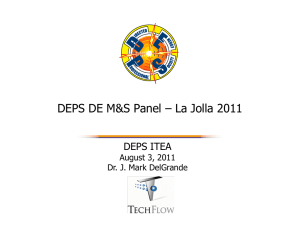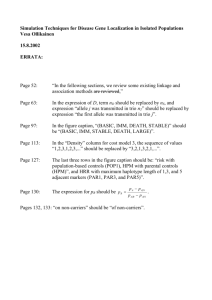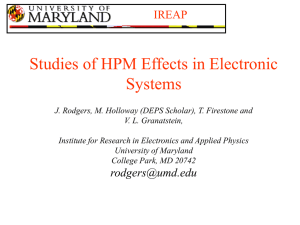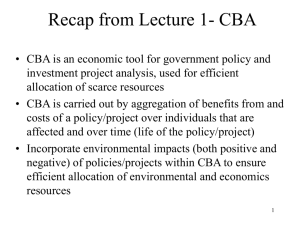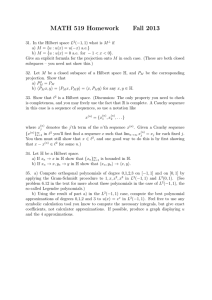Document 10900711
advertisement
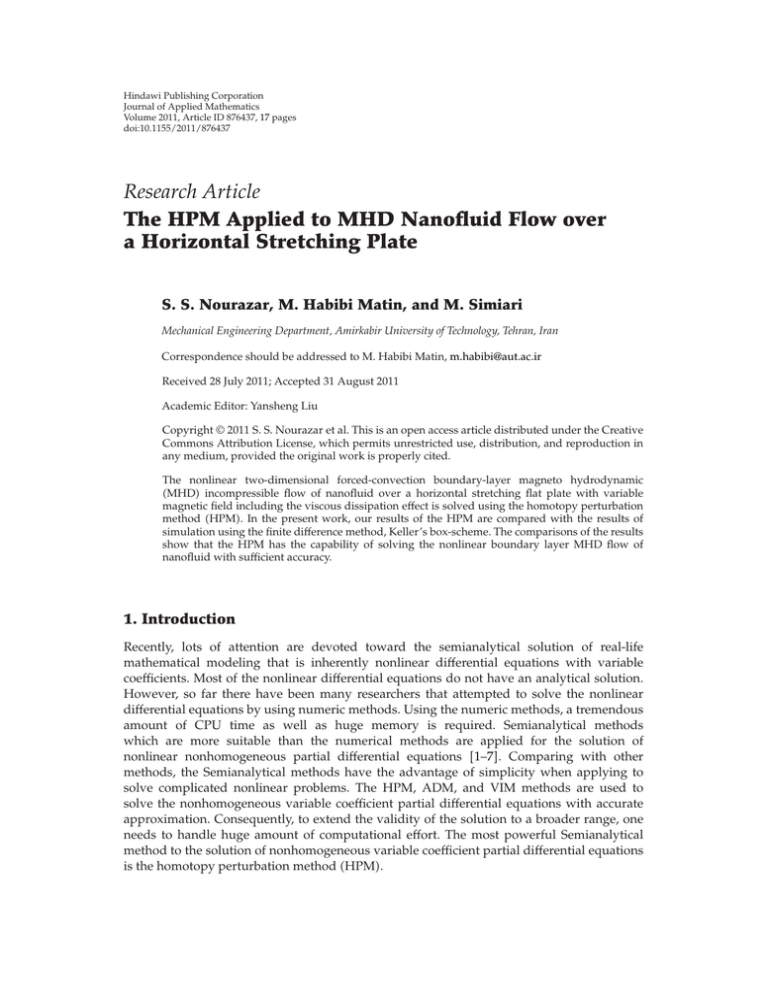
Hindawi Publishing Corporation Journal of Applied Mathematics Volume 2011, Article ID 876437, 17 pages doi:10.1155/2011/876437 Research Article The HPM Applied to MHD Nanofluid Flow over a Horizontal Stretching Plate S. S. Nourazar, M. Habibi Matin, and M. Simiari Mechanical Engineering Department, Amirkabir University of Technology, Tehran, Iran Correspondence should be addressed to M. Habibi Matin, m.habibi@aut.ac.ir Received 28 July 2011; Accepted 31 August 2011 Academic Editor: Yansheng Liu Copyright q 2011 S. S. Nourazar et al. This is an open access article distributed under the Creative Commons Attribution License, which permits unrestricted use, distribution, and reproduction in any medium, provided the original work is properly cited. The nonlinear two-dimensional forced-convection boundary-layer magneto hydrodynamic MHD incompressible flow of nanofluid over a horizontal stretching flat plate with variable magnetic field including the viscous dissipation effect is solved using the homotopy perturbation method HPM. In the present work, our results of the HPM are compared with the results of simulation using the finite difference method, Keller’s box-scheme. The comparisons of the results show that the HPM has the capability of solving the nonlinear boundary layer MHD flow of nanofluid with sufficient accuracy. 1. Introduction Recently, lots of attention are devoted toward the semianalytical solution of real-life mathematical modeling that is inherently nonlinear differential equations with variable coefficients. Most of the nonlinear differential equations do not have an analytical solution. However, so far there have been many researchers that attempted to solve the nonlinear differential equations by using numeric methods. Using the numeric methods, a tremendous amount of CPU time as well as huge memory is required. Semianalytical methods which are more suitable than the numerical methods are applied for the solution of nonlinear nonhomogeneous partial differential equations 1–7. Comparing with other methods, the Semianalytical methods have the advantage of simplicity when applying to solve complicated nonlinear problems. The HPM, ADM, and VIM methods are used to solve the nonhomogeneous variable coefficient partial differential equations with accurate approximation. Consequently, to extend the validity of the solution to a broader range, one needs to handle huge amount of computational effort. The most powerful Semianalytical method to the solution of nonhomogeneous variable coefficient partial differential equations is the homotopy perturbation method HPM. 2 Journal of Applied Mathematics He 8–12 developed the homotopy perturbation method for solving linear, nonlinear, and initial and boundary value problems by combining the standard homotopy and the perturbation methods. The homotopy perturbation method was formulated by taking the full advantage of the standard homotopy and perturbation methods and has been modified later by some scientists to obtain more accurate results, rapid convergence, and to reduce the amount of computation 13–16. Recently, some of researchers have solved many problems in different fields of engineering. Singh et al. 17 solved space-time fractional solidification in a finite slab with HPM. Ajadi and Zuilino 18 applied HPM to reaction-diffusion equations with source term. They concluded that rapid convergence is obtained to the exact solution by HPM. Slota 19 applied the HPM to Stefan solidification heat equation problem, and his results show that HPM is a capable method for solving the problems under consideration. The basic motivation of this paper is to solve a two-dimensional forced-convection boundary-layer MHD problem formed by a magneto hydrodynamic MHD incompressible nanofluid flow in the presence of variable magnetic field over a horizontal flat plate including the viscous dissipation term using the HPM. The two-dimensional forced-convection boundary-layer MHD problem is also simulated with the numerical Keller’s box-scheme 20, and the results of simulation are compared with the results obtained by solving the problem using the HPM. In the present problem, a nanoincompressible fluid in the presence of a variable magnetic field and the viscous dissipation effect over a horizontal stretching flat plate are considered. The results are compared with the previous results of numerical simulation. To our knowledge, there have been no results reported so far for the boundary layer flow of nanofluid, using the HPM method, including the MHD with variable magnetic field, and viscous dissipation effect. 2. Basic Idea of Homotopy Perturbation Method The homotopy perturbation method HPM is originally initiated by He 1–9. This is a combination of the classical perturbation technique and homotopy technique. The basic idea of the HPM for solving nonlinear differential equations is as follows: consider the following nonlinear differential equation: Lu 0 2.1 ∂u 0, B u, ∂n 2.2 subject to boundary condition where L is a general nonlinear differential operator and B is a boundary operator. Usually the main differential equation does not include the small parameter; however, to construct a homotopy, the nonlinear operator is divided into two parts, the first part includes the linear operator, L, and the second part includes the nonlinear operator, N. Therefore, 2.1 is rewritten as Lu Nu 0. 2.3 Journal of Applied Mathematics 3 We now write the homotopy that constructed by He 1–9 as follows: H v, p Lv pNv − 1 − p Lu0 0, 2.4 where p is called the homotopy parameter which is usually assumed to vary between 0, 1. In 2.4, when p is equal to 1 it converts back to the main differential equation 2.1, and in case where p is equal to zero, 2.4 gives the zero-order approximation of the main differential equation 2.1. According to the perturbation method, the approximate solution to 2.4 is expressed as a series of the power of the homotopy parameter p as v v0 pv1 p2 v2 p3 v3 · · · , 2.5 where in the limit when p approaches 1, 2.5 becomes u lim v v0 v1 v2 v3 · · · . 2.6 p→1 3. Mathematical Formulation The governing two-dimensional forced-convection boundary-layer flow over a horizontal stretching flat plate including the viscous dissipation term is written as ∂u ∂v 0, ∂x ∂y ∂u ∂u 1 u v ∂x ∂y ρnf u 3.1 ∂2 u 2 μnf 2 − σBx u , ∂y μnf ∂T ∂T ∂2 T v αnf · 2 ∂x ∂y ∂y ρCp nf ∂u ∂y 2 3.2 . 3.3 Equation 3.1 describes the continuity equation, where u and v are the velocity components in the x and y directions, respectively, see Figure 1. Equation 3.2 describes the twodimensional momentum equation in the presence of a variable magnetic field, where u and v are the x and y components of velocity, respectively, μnf and ρnf are the dynamic viscosity and the density of the nanofluid, respectively, σ is the electrical conductivity, and Bx is the variable magnetic field acting in the perpendicular direction to the horizontal flat plate. Equation 3.3 describes the two-dimensional energy equation including the viscous dissipation term, where, u, v, and T are the x and y components of velocity and temperature, respectively, αnf is the thermal diffusivity, and ρCp nf is the heat capacitance of the nanofluid. The boundary conditions are defined as u uw bxm , u −→ 0, v 0, T −→ T∞ , T Tw , at y 0, as y −→ ∞, 3.4 4 Journal of Applied Mathematics y U∞ , T∞ Tw − T∞ u x B(x) Figure 1: Schematic of the physical model and coordinate system. where uw is the x-component of velocity on the horizontal flat plate, b and m are constants, and Tw and T∞ are the plate and ambient temperatures, respectively. The nanofluid properties such as the density, ρnf , the dynamic viscosity, μnf , the heat capacitance, ρCp nf , and the thermal conductivity, knf , are defined in terms of fluid and nanoparticles properties as in 21, ρnf 1 − φ ρf φρs , μnf μf , 1 − φ2.5 knf ks 2kf − 2φ kf − ks , kf ks 2kf 2φ kf − ks ρCp nf 1 − φ ρCp f φ ρCp s , 3.5 knf αnf , ρCp nf where ρf is the density of fluid, ρs is the density of nanoparticles, φ is defined as the volume fraction of the nanoparticles, μf is the dynamic viscosity of fluid, ρCp f is the thermal capacitance of fluid, ρCp s is the thermal capacitance of nanoparticles, and kf and ks are the thermal conductivities of fluid and nanoparticles, respectively. The variable magnetic field is defined as 22, 23 Bx B0 xm−1 , 3.6 where B0 and m are constant. The following dimensionless similarity variable is used to transform the governing equations into the ordinary differential equations η Rex y Rex 1/2 , x ρf uw x x. μf 3.7 Journal of Applied Mathematics 5 The dimensionless stream function and dimensionless temperature are defined as ψ x, y Rex 1/2 , f η uw x 3.8 T − T∞ θ η , Tw − T∞ where the stream function ψx, y is defined as u ∂ψ , ∂y v− ∂ψ . ∂x 3.9 By applying the similarity transformation parameters, the momentum equation 3.1 and the energy equation 3.2 can be rewritten as 2.5 m 1 2 ρs f ff 1−φ 1−φ φ ρf 2 2.5 2.5 ρs − 1 − φ mf 2 − 1 − φ Mn f 0, 1−φ φ ρf ⎛ ⎞ ρC p Ec Pr θ ⎝ 1 − φ φ s ⎠Prfθ 2.5 0. ρCp f 1−φ 3.10 Therefore, the transformed boundary conditions are f 0 1, f0 0, θ0 1, f ∞ 0, θ∞ 0. 3.11 The dimensionless parameters of Mn, Pr, Ec, and Rex are the magnetic parameter, Prandtl, Eckert, and Reynolds numbers, respectively. They are defined as σ · B02 , Mn ρf · b Pr ρCp f kef υf , Ec uw x2 , Cp ΔT Rex ρf uw x x. μf 3.12 Equation 3.10 is rewritten as f Aff − Bf 2 − Cf 0, 3.13 θ Dfθ Ef 2 0. 3.14 The boundary conditions for f and θ in 3.13 and 3.14 are as follows: f 0 1, f0 0, θ0 1, f ∞ 0, θ∞ 0, 3.15 6 Journal of Applied Mathematics where coefficients, A, B, C, D, and E are written as 2.5 m 1 2 ρs A 1−φ φ , 1−φ ρf 2 2.5 ρs B 1 − φ m, 1−φ φ ρf 2.5 C 1 − φ Mn , ⎛ ⎞ ρCp s D ⎝ 1 − φ φ ⎠Pr, ρCp f 3.16 Ec Pr 2.5 . 1−φ E 4. The HPM Applied to the Problem We are ready now to apply the HPM to solve the similarity nonlinear ordinary differential equations 3.13 and 3.14 with boundary conditions defined as in 3.11. First we construct a homotopy for each of 3.13 and 3.14 as follows: 1 − p f − f0 p f Aff − Bf 2 − Cf 0, 1 − p θ − θ0 p θ Dfθ Ef 2 0. 4.1 4.2 The approximation for each of f and θ in terms of the power series of homotopy parameter p is written as f f0 pf1 p2 f2 p3 f3 · · · n pi fi , 4.3 pi θi . 4.4 i1 θ θ0 pθ1 p2 θ2 p3 θ3 · · · n i1 Substituting 4.3 and 4.4 into 4.1 and 4.2, respectively, and after manipulations, the coefficients of terms of different powers for p are written as follows: p0 :f0 0, f0 0 1, θ0 0, f0 η∞ 0, f0 0 0, θ0 0 1, θ0 η∞ 0, θ0 Df0 θ0 θ1 Ef02 0, p1 :Af0 f0 − ABf0 2 f1 f0 − Kf0 0, f1 0 0, f1 η∞ 0, θ1 0 0, θ1 η∞ 0, f1 0 0, Journal of Applied Mathematics 7 p2 : − Kf1 − 2ABf1 f0 f2 Af0 f1 Af1 f0 0, f2 0 0, f2 η∞ 0, f2 0 0, Df1 θ0 2Ef0 f1 θ2 Df0 θ0 0, θ2 0 0, θ2 η∞ 0, p3 : − Kf2 − 2ABf0 f2 f3 Af1 f1 Af2 f0 0, Df2 θ0 Df1 θ1 Ef12 Df0 θ2 θ3 2Ef0 f2 0, f3 0 0, f3 η∞ 0, f3 0 0, θ3 0 0, θ3 η∞ 0. 4.5 The above sets of recursive ordinary differential equations along with their boundary conditions are solved using the MAPLE software. Some samples of these functions obtained by the MAPLE software are brought to the reader’s attention as follows: 1 f0 η η − η2 , 10 7.333333333 5 1.833333333 4 6.875000000 2 η η − η , f1 η − 100000 1000 100 1.056349206 8 4.225396825 7 4.03333333 6 η η − η f2 η − 10000000 1000000 100000 − 1.008333333 5 1.260416667 4 4.501488101 2 η η η , 10000 1000 1000 1.600529100 11 8.802910053 10 1.514100529 9 η η − η f3 η − 10000000000 1000000000 10000000 5.743898810 8 5.809920634 7 2.772916667 6 η η − η 10000000 1000000 100000 − 2.805927579 5 8.252728185 4 3.197932176 2 η − η η , 100000 100000 1000 1.679143807 13 4.131499118 12 2.398776866 η14 η − η f4 η − 10000000000000 100000000000 10000000000 3.693701059 11 4.599520498 10 2.081888227 9 η η − η 1000000000 1000000000 10000000 4.091584733 8 1.616748748 7 1.815600201 6 η η η 10000000 1000000 1000000 9.229301027 5 5.862875656 4 2.794411931 2 η − η − η , 1000000 100000 1000 f5 η − 3.008718359 9.621663665 3.539668656 η17 η16 − η15 10000000000000000 100000000000000 10000000000000 1.336240956 14 4.703056270 13 6.487744707 12 η − η − η 100000000000 100000000000 10000000000 8 Journal of Applied Mathematics 5.258958021 11 1.973384501 10 5.793349681 9 η η − η 1000000000 1000000000 100000000 − 4.024040085 8 5.317835354 7 1.289832644 6 η − η η 100000000 10000000 1000000 − 1.022487452 5 5.123088540 4 1.227506044 2 η η η , 1000000 100000 1000 1 θ0 η 1 − η, 5 197 3 611 2 3541 197 4 θ1 η − η η − η − η, 250000 12500 250000 12500 θ2 η − θ3 η − 243689 381234399997 20923179307 5 2571375199 4 η7 η6 − η − η 65625000000 3000000000000000 20000000000000 1200000000000 4353487 3 1568233333 2 18522049449 η − η η, 187500000 200000000000 448000000000 128997197 600744859 1348247347 η10 η9 − η8 90000000000000000 180000000000000 56000000000000 68494603 1127538653 6 3252643783 5 2291723651 4 η7 η − η − η 2100000000000 3000000000000 2000000000000 4000000000000 − 546104693 3 926887907 2 11162966633099 η − η η, 300000000000 250000000000 201600000000000 θ4 η − 1051026059 2184149803 4078298911 η13 η11 η10 78000000000000000000 330000000000000000 4500000000000000 309004361 1846846597 2550925297 η9 − η8 η7 180000000000000 56000000000000 42000000000000 219441079 582975921 186565583 4 η6 − η5 η 1200000000000 20000000000000 150000000000 − 2901970381 3 239346723 2 698438049321211 η η − η, 600000000000 80000000000 9225216000000000 θ5 η − 833864223 1944523579 η16 η15 12000000000000000000000 70000000000000000000 − 368935767 184656149 2568874313 η14 η13 − η12 1137500000000000000 52000000000000000 6600000000000000000 − 3176798263 1479712693 128033843 η11 η10 η9 11000000000000000 900000000000000 90000000000000 − 536161247 1526910869 2319614257 η8 η7 − η6 28000000000000 140000000000000 15000000000000 6768377991 2079006273 4 308834747 3 η5 − η η 20000000000000 4000000000000 50000000000 − 4211857587 2 191966732445473917 η η. 2000000000000 3690086400000000000 4.6 Journal of Applied Mathematics 9 1 0.8 0.6 f′ 0.4 0.2 0 0 1 3 2 4 5 η HPM (S = 8) HPM (S = 12) NM HPM (S = 4) Figure 2: Comparison of dimensionless velocity profiles versus the normalized coordinates using the Keller’s box numerical method with the results obtained by HPM at Ec 0.1, m 0, Pr 6.2, ϕ 0.2, and Mn 0.2. Table 1: Thermophysical properties of water and nanoparticles. Fluid water Nanoparticles Al2 O3 ρ kg m−3 997.1 3970 Cp J kg−1 K−1 4179 765 0.613 40 Physical properties −1 −1 k W m K These functions, f and θ, are calculated for the case where, Ec 0.1, m 0, Pr 6.2, ϕ 0.2, and Mn 0.2. The physical properties of the fluid, water, and the nanoparticles, aluminum oxide Al2 O3 , are given in Table 1. 5. Numerical Method The differential equations, 3.13 and 3.14, along with the boundary conditions, 3.15, are split into five first-order differential equations by introducing new dependent variables. The five split first-order differential equations are discretized using the first-order backward finite difference scheme, the so-called Keller’s box method 20. The discretized form of the five split differential equations are linearized using the Newton’s method 24–26. The discretized and linearized equations form a system of block-tridiagonal equations which are solved using the block-tridiagonal-elimination technique 26. A step size of Δη 0.005 is selected to satisfy the convergence criterion of 10−4 in all cases. In our simulation, η∞ is chosen to be equal to 5 in order to suffice for taking into account the full effect of boundary layer growth. Then the differential equations, 3.13 and 3.14, along with the boundary conditions, 3.15, are solved using the HPM. The recursive differential equations 10 Journal of Applied Mathematics 1 0.8 0.6 θ 0.4 0.2 0 0 1 NM HPM (S = 4) 2 η 3 4 5 HPM (S = 8) HPM (S = 12) Figure 3: Comparison of dimensionless temperature profiles versus the normalized coordinates using the Keller’s box numerical method with the results obtained by HPM at Ec 0.1, m 0, Pr 6.2, ϕ 0.2, and Mn 0.2. with the relevant boundary conditions resulting from the HPM are solved using the MAPLE software. 6. Results and Discussions Table 2 shows the comparison between the results obtained from HPM and the results obtained from the numerical method NM at Ec 0.1, m 0, Pr 6.2, ϕ 0.2, and Mn 0.2. The comparison of the results obtained from the HPM and the results obtained from the NM shows excellent agreements at different values of the similarity parameter. Figure 2 shows the comparison of dimensionless velocity profiles versus the normalized coordinates using the Keller’s box numerical method with the results obtained by the HPM at Ec 0.1, m 0, Pr 6.2, ϕ 0.2, and Mn 0.2. The results obtained from the HPM are reported for three different sums of terms, S 4, 8, and 12, in the HPM series solution. It is obvious from Figure 2 that as the number of sums of terms in the HPM series solution increases, the results approach towards the profile obtained from the NM. The mean discrepancies between the results of velocity obtained from the HPM for S 12 and the results obtained from the NM are at most 2%. Figure 3 shows the comparison of dimensionless temperature profiles versus the normalized coordinates using the Keller’s box numerical method with the results obtained by the HPM at Ec 0.1, m 0, Pr 6.2, ϕ 0.2, and Mn 0.2. The results obtained from the HPM are reported for three different sums of terms, S 4, 8, and 12, in the HPM series solution. As the number of sums of terms in the HPM series solution increases the agreement between the results obtained from the HPM and the results obtained from the NM is more pronounced. The mean discrepancies between the results of temperature obtained from the HPM for S 12 and the results obtained from the NM are less than 5%. Figure 4 shows the comparison of dimensionless velocity profiles versus the normalized coordinates Journal of Applied Mathematics 11 Table 2: Comparison between HPM and NM at Ec 0.1, m 0, Pr 6.2, ϕ 0.2, and Mn 0.2. NM η 0 f HPM θ f θ 1 1 1 1 0.2 0.9110 0.9134 0.911545 0.914671 0.4 0.8272 0.8276 0.827806 0.830011 0.6 0.7481 0.7442 0.748988 0.747524 0.8 0.6744 0.6643 0.675187 0.668484 1 0.606 0.5889 0.606404 0.593911 1.2 0.5427 0.5185 0.542561 0.524578 1.4 0.4844 0.4536 0.483516 0.461022 1.6 0.4309 0.3944 0.429079 0.403573 1.8 0.3819 0.3408 0.379026 0.352385 2 0.3373 0.2928 0.333116 0.307456 2.2 0.2966 0.2499 0.291102 0.268638 2.4 0.2596 0.2121 0.252741 0.235634 2.6 0.2260 0.1786 0.217807 0.207977 2.8 0.1955 0.1493 0.186097 0.185003 3 0.1679 0.1237 0.157437 0.165822 3.2 0.1428 0.1015 0.131683 0.149317 3.4 0.1202 0.0822 0.108713 0.134198 3.6 0.0994 0.0656 0.088417 0.119118 3.8 0.0806 0.0512 0.070676 0.102891 4 0.0635 0.0388 0.055326 0.084773 4.2 0.0479 0.0281 0.042121 0.064787 4.4 0.0336 0.0130 0.030677 0.043964 4.6 0.0205 0.0112 0.020429 0.024391 4.8 0.0085 0.0044 0.010565 0.008861 0 0 0 0 5 using the Keller’s box numerical method with the results obtained by the HPM at Ec 0.1, m 0, Pr 6.2, ϕ 0.2, and Mn 0. The results obtained from the HPM are reported for three different number of sums of terms, S 4, 8, and 12, in the HPM series solution. As the number of sums of terms in the HPM series solution increases the agreement between the results of dimensionless velocity obtained from the HPM and the results obtained from the NM is more pronounced. The results of velocity obtained from the HPM for S 8 and 12 and the results obtained from the NM are almost the same. Figure 5 shows the comparison of dimensionless temperature profiles versus the normalized coordinates using the Keller’s box numerical method with the results obtained by the HPM at Ec 0.1, m 0, Pr 6.2, ϕ 0.2, and Mn 0. The results obtained from the HPM are reported for three different sums of terms, S 4, 8, and 12, in the HPM series solution. However, as the number of sums of terms in the HPM series solution increases, the agreement between the results obtained from the HPM and the results obtained from the NM is more apparent. For the temperature profiles, the mean discrepancies between the results obtained from the HPM when S 12 and the results obtained from the NM are at most 8%, whereas the discrepancies between the results 12 Journal of Applied Mathematics 1 0.8 0.6 f ′ 0.4 0.2 0 0 1 2 η 3 4 5 NM HPM (S = 4) HPM (S = 8, 12) Figure 4: Comparison of dimensionless velocity profiles versus the normalized coordinates using the Keller’s box numerical method with the results obtained by HPM at Ec 0.1, m 0, Pr 6.2, ϕ 0.2, and Mn 0. 1 0.8 0.6 θ 0.4 0.2 0 0 1 NM HPM (S = 4) 2 η 3 4 5 HPM (S = 8) HPM (S = 12) Figure 5: Comparison of dimensionless temperature profiles versus the normalized coordinates using the Keller’s box numerical method with the results obtained by HPM at Ec 0.1, m 0, Pr 6.2, ϕ 0.2, and Mn 0. obtained for velocity from HPM and NM are negligible at the same conditions. The reason of this behavior is due to the complex nonlinearity that exists in the nature of the governing equations which makes it so difficult to exactly realize the obsessive interaction existing in the problem. Figure 6 shows the comparison between dimensionless velocity profiles versus the normalized coordinates using the Keller’s box numerical method and the results obtained by Journal of Applied Mathematics 13 1 0.8 0.6 f ′ 0.4 0.2 0 0 1 NM HPM (S = 4) 2 η 3 4 5 HPM (S = 8) HPM (S = 12) Figure 6: Comparison of dimensionless velocity profiles versus the normalized coordinates using the Keller’s box numerical method with the results obtained by HPM at Ec 0, m 0, Pr 6.2, ϕ 0.2, and Mn 0.2. the HPM at Ec 0, m 0, Pr 6.2, ϕ 0.2, and Mn 0.2. The results obtained from the HPM are reported for three different sums of terms S 4, 8, and 12 in the HPM series solution. Figure 7 shows the comparison of dimensionless temperature profiles versus the normalized coordinates using the Keller’s box numerical method with the results obtained by the HPM at Ec 0.1, m 0, Pr 6.2, ϕ 0.2, and Mn 0.2. The results obtained from the HPM are reported for three different sums of terms, S 4, 8, and 12, in the HPM series solution. It is obvious that as the number of sums of terms in the HPM series solution increases, the results approach toward the profile obtained from the NM. The mean discrepancies between the results of velocity obtained from the HPM for S 12 and the results obtained from the NM are at most 5%. Figure 8 shows the comparison between dimensionless velocity profiles versus the normalized coordinates using the Keller’s box numerical method with the results obtained by the HPM at Ec 0.1, m 0.1, Pr 6.2, ϕ 0.2, and Mn 0.2. The results obtained from the HPM are reported for three different numbers of sums of terms, S 4, 8, and 12, in the HPM series solution. One can realize from Figure 8, as the number of sums of terms in the HPM series solution increases, the results approach toward the profile obtained from the NM. The mean discrepancies between the results of velocity obtained from the HPM for S 12 and the results obtained from the NM are at most 5%. Figure 9 shows the comparison of dimensionless temperature profiles versus the normalized coordinates using the Keller’s box numerical method with the results obtained by the HPM at Ec 0.1, m 0.1, Pr 6.2, ϕ 0.2, and Mn 0.2. The results obtained from the HPM are reported for three different numbers of sums of terms, S 4, 8, and 12, in the HPM series solution. As the number of sums of terms in the HPM series solution increases, the results approach towards the profile obtained from the NM. The mean discrepancies between the results of velocity obtained from the HPM for S 12 and the results obtained from the NM are at most 4%. 14 Journal of Applied Mathematics 1 0.8 0.6 θ 0.4 0.2 0 0 1 3 2 4 5 η HPM (S = 8) HPM (S = 12) NM HPM (S = 4) Figure 7: Comparison of dimensionless temperature profiles versus the normalized coordinates using the Keller’s box numerical method with the results obtained by HPM at Ec 0, m 0, Pr 6.2, ϕ 0.2, and Mn 0.2. 1 0.8 0.6 f ′ 0.4 0.2 0 0 1 3 2 4 5 η NM HPM (S = 4) HPM (S = 8) HPM (S = 12) Figure 8: Comparison of dimensionless velocity profiles versus the normalized coordinates using the Keller’s box numerical method with the results obtained by HPM at Ec 0.1, m 0.1, Pr 6.2, ϕ 0.2, and Mn 0.2. 7. Conclusions In this work, the nonlinear two-dimensional forced-convection boundary-layer magneto hydrodynamic MHD incompressible flow of nanofluid over a horizontal stretching flat plate with variable magnetic field including the viscous dissipation effect is solved using the homotopy perturbation method HPM. The results are justified and compared with the results obtained from the numerical method NM. Our results obtained from the HPM, Journal of Applied Mathematics 15 1 0.8 0.6 θ 0.4 0.2 0 0 1 2 3 4 5 η NM HPM (S = 4) HPM (S = 8) HPM (S = 12) Figure 9: Comparison of dimensionless temperature profiles versus the normalized coordinates using the Keller’s box numerical method with the results obtained by HPM at Ec 0.1, m 0.1, Pr 6.2, ϕ 0.2, and Mn 0.2. when the number of sums of terms in the HPM series solution increases, showed a monotonic convergence towards the results using the NM. The results obtained from the HPM show at most less than 8% mean deviations when compared with the results obtained from the NM. For the nonlinear MHD problem, this is encouraging because these results are only achieved by including at most S 12 number of sums of terms in the HPM series solution. Nomenclature Bx: b: Ec: Cp s : Cp f : f: ks : kf : m: Mn: Pr: Re: S: T: T∞ : Tw : u: v: Magnetic field Constant parameter Eckert number Thermal capacitance of solid Thermal capacitance of fluid Dimensionless velocity variable Thermal conductivity of nanoparticles Thermal conductivity of fluid Index of power law velocity Magnetic parameter Prandtl number Reynolds number No. of terms in the HPM Absolute temperature Constant temperature of the fluid far away from the plate Given temperature at the plate Velocity in x-direction Velocity in y-direction 16 Journal of Applied Mathematics uw : Velocity of the plate x: Horizontal coordinate y: Vertical coordinate. Greek Symbols σ: θ: ψ: μf : ϕ: ρs : ρf : Electrical conductivity Dimensionless temperature Stream function Fluid viscosity Nanoparticles volume fraction nanoparticles density Fluid density. References 1 J. H. He, Non-perturbative methods for strongly nonlinear problems [Ph.D. thesis], de-Verlag im Internet GmbH, Berlin, Germany, 2006. 2 J.-H. He, “Some asymptotic methods for strongly nonlinear equations,” International Journal of Modern Physics B, vol. 20, no. 10, pp. 1141–1199, 2006. 3 J.-H. He, “Homotopy perturbation method for solving boundary value problems,” Physics Letters A, vol. 350, no. 1-2, pp. 87–88, 2006. 4 J. H. He, “Application of homotopy perturbation method to nonlinear wave equations,” Chaos, Solitons & Fractals, vol. 26, no. 3, pp. 695–700, 2005. 5 J.-H. He, “Approximate analytical solution for seepage flow with fractional derivatives in porous media,” Computer Methods in Applied Mechanics and Engineering, vol. 167, no. 1-2, pp. 57–68, 1998. 6 J. H. He, “Approximate solution of nonlinear differential equations with convolution product nonlinearities,” Computer Methods in Applied Mechanics and Engineering, vol. 167, no. 1-2, pp. 69–73, 1998. 7 J. H. He, “Variational iteration method—a kind of non-linear analytical technique: some examples,” International Journal of Non-Linear Mechanics, vol. 34, no. 4, pp. 699–708, 1999. 8 J.-H. He, “Homotopy perturbation technique,” Computer Methods in Applied Mechanics and Engineering, vol. 178, no. 3-4, pp. 257–262, 1999. 9 J.-H. He, “A coupling method of a homotopy technique and a perturbation technique for non-linear problems,” International Journal of Non-Linear Mechanics, vol. 35, no. 1, pp. 37–43, 2000. 10 J.-H. He and X.-H. Wu, “Construction of solitary solution and compacton-like solution by variational iteration method,” Chaos, Solitons & Fractals, vol. 29, no. 1, pp. 108–113, 2006. 11 J.-H. He, “Periodic solutions and bifurcations of delay-differential equations,” Physics Letters A, vol. 347, no. 4-6, pp. 228–230, 2005. 12 J. H. He, “Limit cycle and bifurcation of nonlinear problems,” Chaos, Solitons & Fractals, vol. 26, no. 3, pp. 827–833, 2005. 13 J. H. He, “Homotopy perturbation method for bifurcation of nonlinear problems,” International Journal of Nonlinear Sciences and Numerical Simulation, vol. 6, no. 2, pp. 207–208, 2005. 14 P. D. Ariel, T. Hayat, and S. Asghar, “Homotopy perturbation method and axisymmetric flow over a stretching sheet,” International Journal of Nonlinear Sciences and Numerical Simulation, vol. 7, no. 4, pp. 399–406, 2006. 15 D. D. Ganji and S. H. Hashemi Kachapi, “Analysis of nonlinear equations in fluids,” Progress in Nonlinear Science, vol. 2, pp. 1–293, 2011. 16 D. D. Ganji and S. H. Hashemi Kachapi, “Analytical and Numerical Methods in Engineering and Applied Sciences,” Progress in Nonlinear Science, vol. 3, pp. 1–579, 2011. 17 J. Singh, P. K. Gupta, K. N. Rai, and CIMS-DST, “Homotopy perturbation method to space-time fractional solidification in a finite slab,” Applied Mathematical Modelling. Simulation and Computation for Engineering and Environmental Systems, vol. 35, no. 4, pp. 1937–1945, 2011. 18 S. O. Ajadi and M. Zuilino, “Approximate analytical solutions of reaction-diffusion equations with exponential source term: homotopy perturbation method HPM,” Applied Mathematics Letters, vol. 24, no. 10, pp. 1634–1639, 2011. Journal of Applied Mathematics 17 19 D. Slota, “The application of the homotopy perturbation method to one-phase inverse Stefan problem,” International Communications in Heat and Mass Transfer, vol. 37, no. 6, pp. 587–592, 2010. 20 H. B. Keller, “A new difference scheme for parabolic problems,” in Numerical Solution of Partial Differential Equations, II, pp. 327–350, Academic Press, New York, NY, USA, 1971. 21 S. M. Aminossadati and B. Ghasemi, “Natural convection cooling of a localised heat source at the bottom of a nanofluid-filled enclosure,” European Journal of Mechanics, B, vol. 28, no. 5, pp. 630–640, 2009. 22 T. C. Chiam, “Hydromagnetic flow over a surface stretching with a power-law velocity,” International Journal of Engineering Science, vol. 33, no. 3, pp. 429–435, 1995. 23 S. P. A. Devi and M. Thiyagarajan, “Steady nonlinear hydromagnetic flow and heat transfer over a stretching surface of variable temperature,” Heat and Mass Transfer, vol. 42, no. 8, pp. 671–677, 2006. 24 T. Cebeci and P. Bradshaw, Momentum Transfer in Boundary Layers, Hemisphere Publishing Corporation, New York, NY, USA, 1997. 25 T. Cebeci and P. Bradshaw, Physical and Computational Aspects of Convective Heat Transfer, Springer Study Editions, Springer-Verlag, New York, NY, USA, 1988. 26 M. Z. Salleh, S. Ahmad, and R. Nazar, “Numerical solutions of the forced convection boundary layer flow at a forward stagnation point,” European Journal of Scientific Research, vol. 19, no. 4, pp. 644–653, 2008. Advances in Operations Research Hindawi Publishing Corporation http://www.hindawi.com Volume 2014 Advances in Decision Sciences Hindawi Publishing Corporation http://www.hindawi.com Volume 2014 Mathematical Problems in Engineering Hindawi Publishing Corporation http://www.hindawi.com Volume 2014 Journal of Algebra Hindawi Publishing Corporation http://www.hindawi.com Probability and Statistics Volume 2014 The Scientific World Journal Hindawi Publishing Corporation http://www.hindawi.com Hindawi Publishing Corporation http://www.hindawi.com Volume 2014 International Journal of Differential Equations Hindawi Publishing Corporation http://www.hindawi.com Volume 2014 Volume 2014 Submit your manuscripts at http://www.hindawi.com International Journal of Advances in Combinatorics Hindawi Publishing Corporation http://www.hindawi.com Mathematical Physics Hindawi Publishing Corporation http://www.hindawi.com Volume 2014 Journal of Complex Analysis Hindawi Publishing Corporation http://www.hindawi.com Volume 2014 International Journal of Mathematics and Mathematical Sciences Journal of Hindawi Publishing Corporation http://www.hindawi.com Stochastic Analysis Abstract and Applied Analysis Hindawi Publishing Corporation http://www.hindawi.com Hindawi Publishing Corporation http://www.hindawi.com International Journal of Mathematics Volume 2014 Volume 2014 Discrete Dynamics in Nature and Society Volume 2014 Volume 2014 Journal of Journal of Discrete Mathematics Journal of Volume 2014 Hindawi Publishing Corporation http://www.hindawi.com Applied Mathematics Journal of Function Spaces Hindawi Publishing Corporation http://www.hindawi.com Volume 2014 Hindawi Publishing Corporation http://www.hindawi.com Volume 2014 Hindawi Publishing Corporation http://www.hindawi.com Volume 2014 Optimization Hindawi Publishing Corporation http://www.hindawi.com Volume 2014 Hindawi Publishing Corporation http://www.hindawi.com Volume 2014
